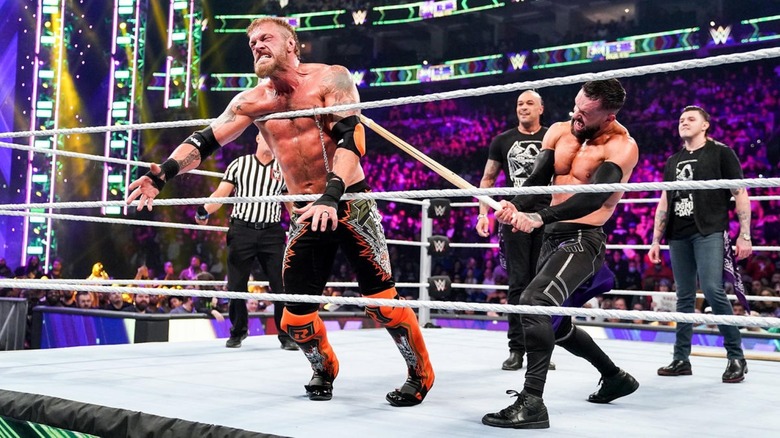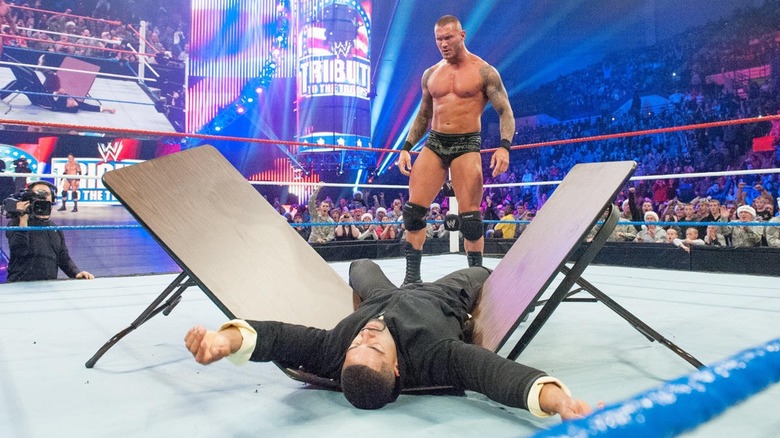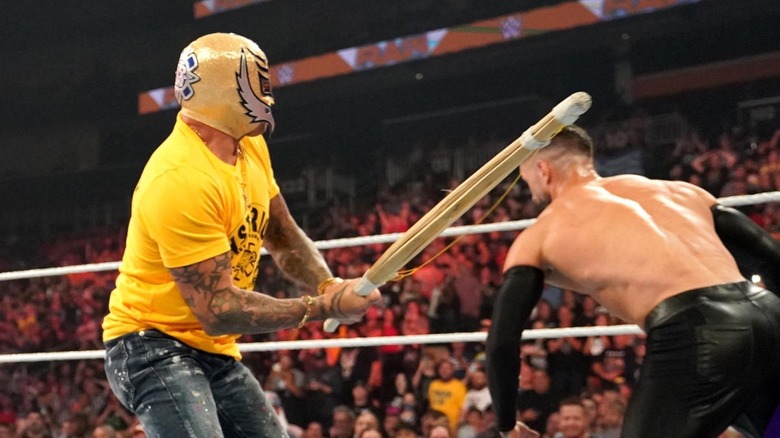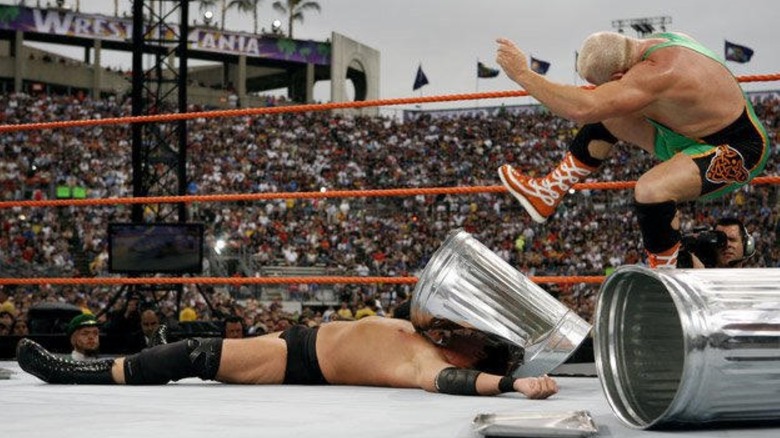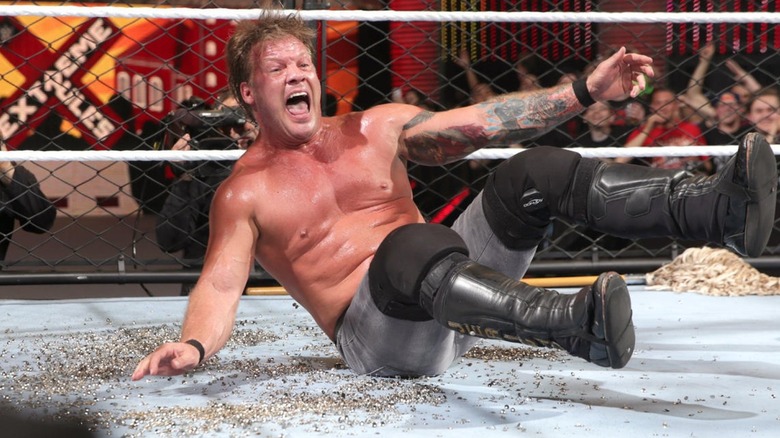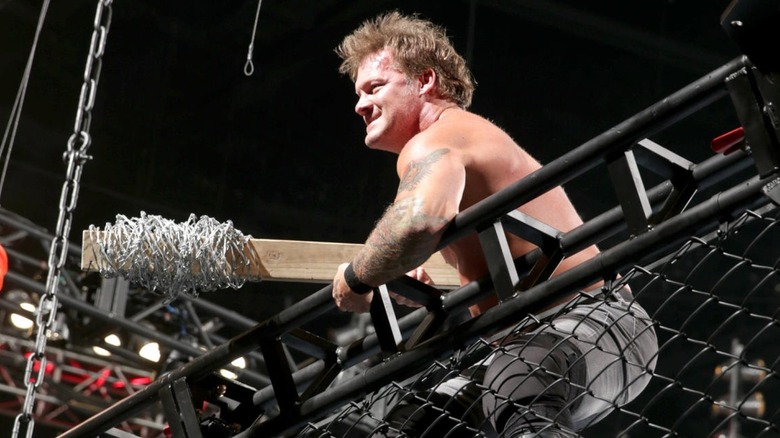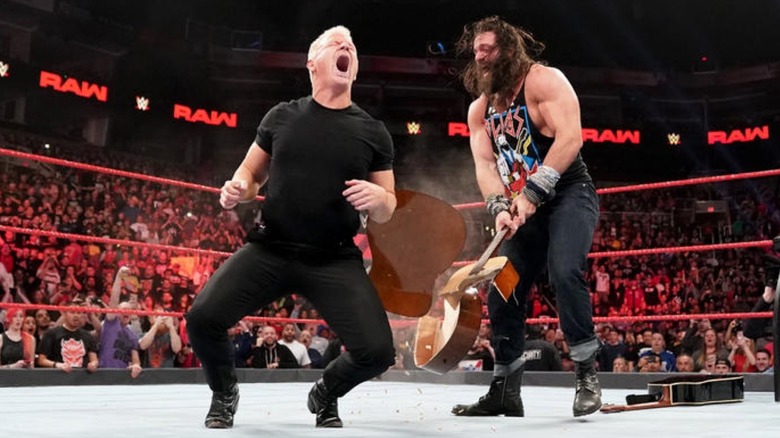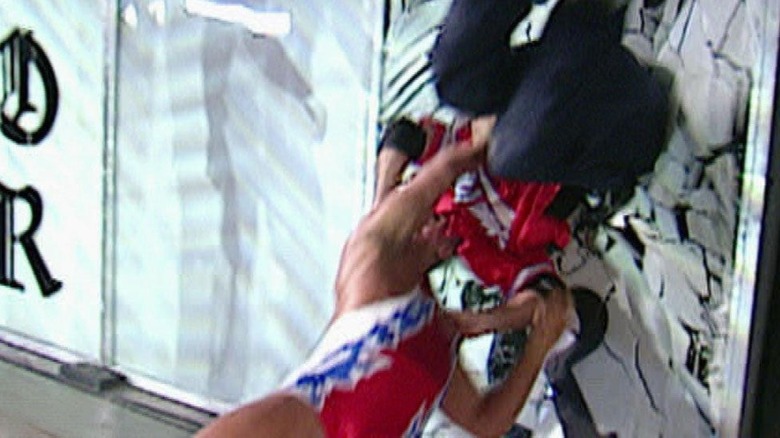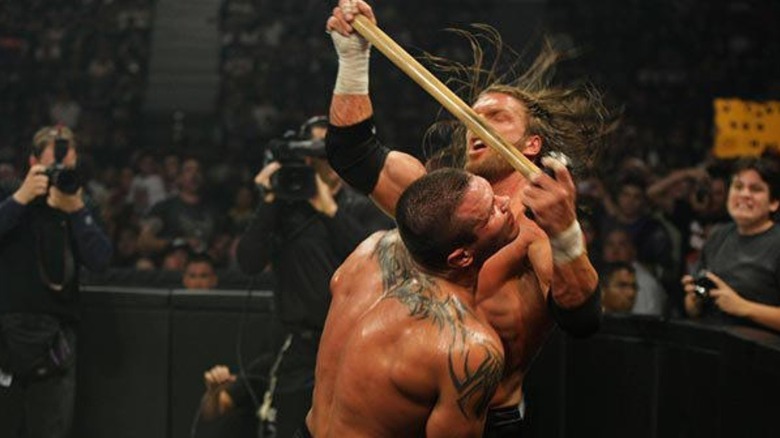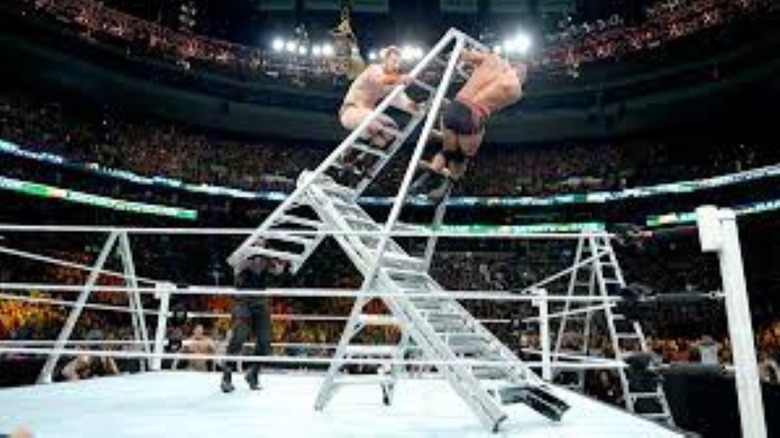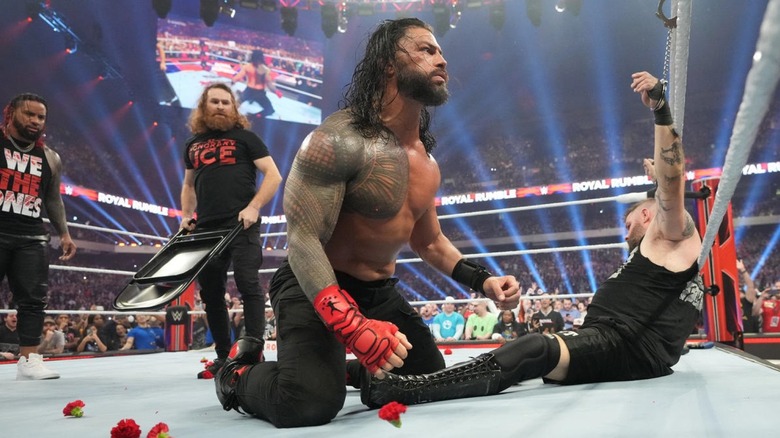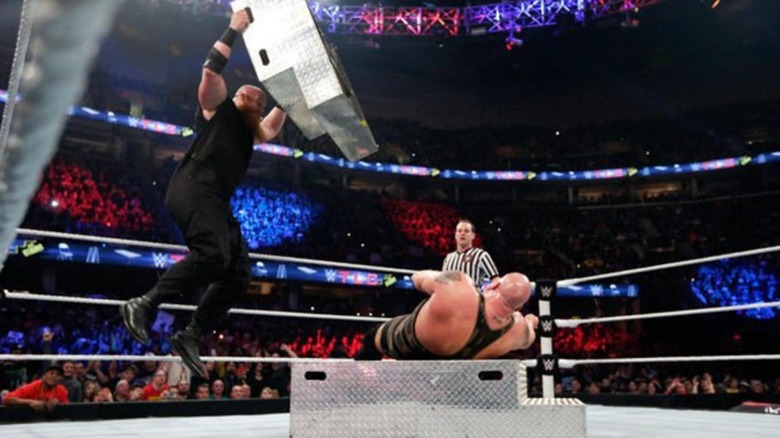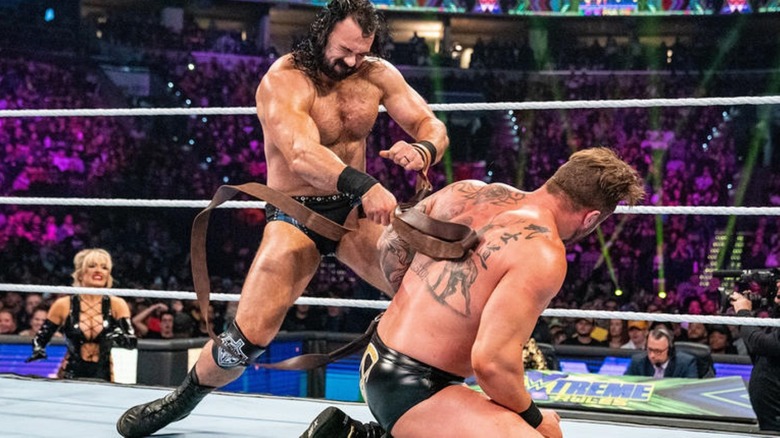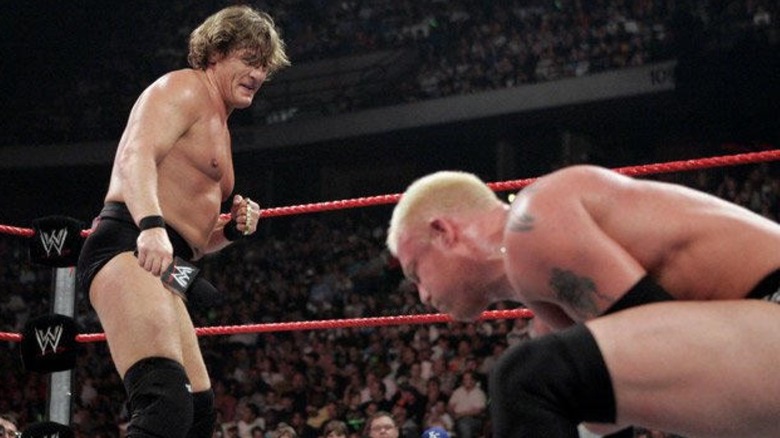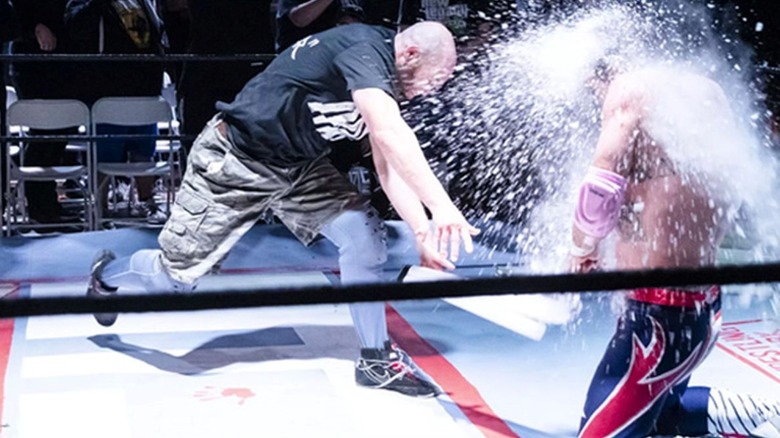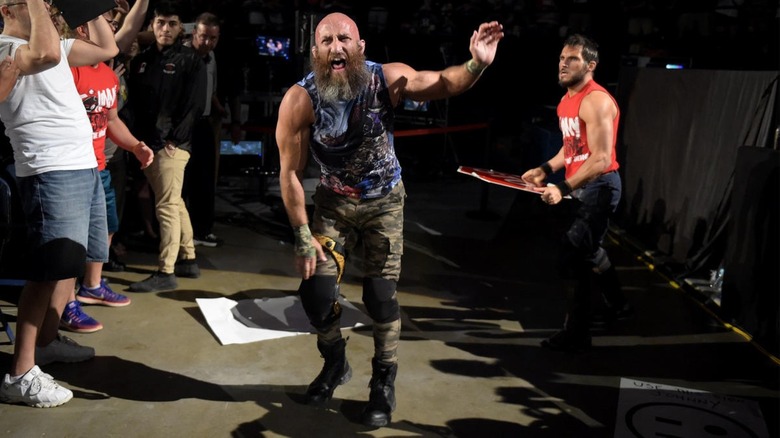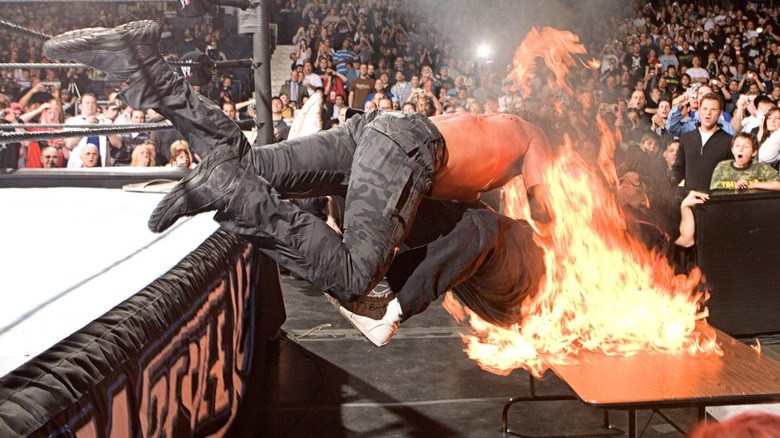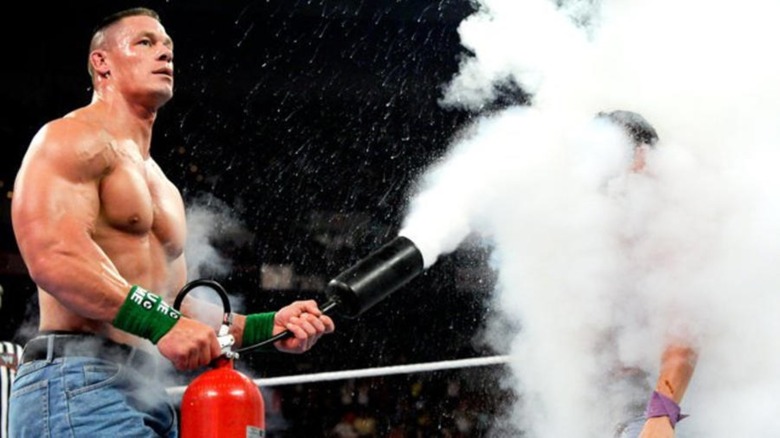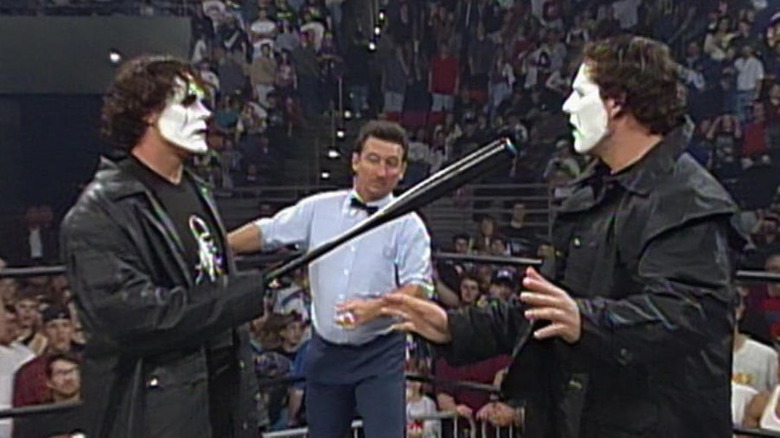Are These WWE Props Real Or Fake?
As a sports/entertainment hybrid, wrestling often operates on the more theatrical end of the competitive spectrum. Sometimes the story requires the rules to be stripped away so two rivals can beat one another to oblivion and back, and what better way to do that than incorporate weapons? At other times, wrestling's performative nature will see plunder brought into the fold simply to please the crowd. Perhaps this is best illustrated by the frequent chant "We want tables," commonly shouted by thousands in attendance.
Of course, wrestling usually prefers the illusion of danger to the real thing, leaving those watching in awe but those in the ring safe from the damage foreign objects can do. That's where the business draws from the wider entertainment industry in its use of various types of smoke and mirrors. As time went on — especially after WWE started producing a PG product — safer prop weapons have been developed. But not everything you see can be entirely risk-free.
If you've ever watched a wrestler go through a table, run through their opponents with a ladder, or smash someone with a steel chair, and asked yourself, "That can't be real, right?", read further and find out which of your favorite WWE weapons are real or fake, lifting the lid on how wrestlers keep themselves safe while still putting their bodies on the line.
Tables
Tables have grown to be one of the more long-standing and popular props integrated into wrestling. There is perhaps no more satisfying a sight than seeing a dastardly villain get theirs by crashing through a table, exploding on impact, and leaving them crumpled in a heap. But the tables seen within wrestling are not the sort you would want Thanksgiving supper on.
As opposed to the thick-set wood often used to give tables their stability and ability to bear weight, tables in wrestling are made from an extremely thin chipboard. The board can support carefully applied weight, such as a worker sprawled across, but with a little force, the table will snap in half. It actually means the table can serve as a crash pad of sorts, as has been seen in various matches. But this method doesn't come without its shortfalls; sometimes the flimsy nature of the table means they can break before the planned spot, or they can fail to support weight, causing a moment of confusion akin to a firework misfiring. The situation can go in the other direction too, with the table refusing to break if not enough downward force is applied. They aren't entirely risk-free either, given that the table is supported on metal legs.
The announcer's desk works like the other tables, constructed like flat-pack furniture for performers to go through. Nowadays they are relatively bare, with just a few small screens for the commentators to keep track of the in-ring action. Before a bump, the table is cleared of its cover, screens, and any other objects that can hamper the landing. Once upon a time, the announcer's desk had large monitors built into it. Fans need only re-watch Randy Orton delivering an RKO to Daniel Bryan through the table at WrestleMania 30 to understand how painful a landing on those can be. The tables used in Japan, unlike WWE, are made of real wood and rarely break.
Kendo sticks
Kendo sticks — also referred to as Singapore canes in ECW and Shinai in Japan — are one of the more iconic weapons within WWE today. A wrestler will lash their opponent with the stick, producing a loud crack with each strike as the stick splinters and explodes. But once again, they have been modified in a way to look more painful than they are. They are usually made from hollow sticks of bamboo, taped together at each end, which produces a large cracking sound and softens the actual force behind each blow.
The tape at each end not only keeps the sticks together, but ensures that when they splinter the jagged edge shouldn't impale its subject. However, they aren't perfect in this regard. "Big Show" Paul Wight suffered an eye injury at One Night Stand 2008, as a result of a splintered kendo stick. It also should be stated that while they aren't solid wood, the Kendo sticks have been seen to cause welts on impacted bodies.
Dominik Mysterio showed the bruising the stick can cause in 2020, after he was the subject of a mauling from Seth Rollins and Buddy Murphy. A trick of the trade wrestlers use to dissipate the pain when taking a Kendo stick shot is taking the strike on a larger surface area — like the back or front torso. This not only spreads the impact so the pain is less concentrated, but also ensure there is little chance of an adverse shot hitting a protected region and causing injury.
Trash cans
The trash can has become a staple of matches contested under "Street Fight" rules within WWE. Wrestlers have made use of them both as painful landing spots or blunt force objects against their adversaries, each shot crumpling the can around the limb struck. But there is a reason the cans seen in wrestling have more give in them. So don't try using your household trash can on your friends.
The trash cans in wrestling are usually made from aluminum or tin for malleability and reduced weight. They are effectively no thinner than that of a soda can, so like most props they appear more painful than they actually are. That's a good thing too, as a common trashcan wouldn't have the desired crumpling effect when a worker is dumped on them. Not only do they mitigate the pain for those taking the move, they are far more satisfying for onlookers.
Their versatility has been tested throughout the years, with Shane McMahon adopting the item into his Coast-to-Coast maneuver. He would prop the can atop a wrestler in the corner, delivering a drop kick from the parallel corner onto his opponent below. Now, without the trash can, there is a degree of risk which comes with a flying kick to the face. However, with it added there is a cushion in between the bodies, alleviating some of the cause for concern in the move and also making an immensely satisfying crashing sound when completed.
Thumbtacks
In the wider wrestling industry, thumbtacks remain one of the most popular plunder items brought into hardcore matches. Their mere introduction often provokes a pop from the crowd, building up to the moment when a worker takes a dastardly plunge onto the pins, puncturing the skin and often remaining until they are removed. In WWE, they are a rarity, given its PG presentation and the added fact that they cannot be faked in any way. That's right, they are as real as it gets.
They did make a surprise cameo during 2016's "Ambrose Asylum" match between Chris Jericho and Dean Ambrose — AEW's Jon Moxley — however, with Jericho falling back-first onto the tacks. Jericho later described taking the bump as more painful in its idea. He said that the suspense during the match built up, internalizing what it would actually feel like to land on them. Randy Orton fell onto thumbtacks delivering an RKO to Mick Foley during Backlash 2004, which Foley said Orton almost immediately regretted. Foley has also described the feeling of removing tacks as more painful than receiving them, ranking them low on his risk/reward factor.
Once more, to reduce the risk and pain of thumbtacks, wrestlers often land on them with a larger surface area to spread out the impact. By many accounts, taking them to the face and hands is the most painful. Despite being renowned for his hardcore ringwork, Foley described taking tacks that way as "dumb", conceding that also applies to him. WWE has since made use of Lego bricks instead of tacks, as seen during the "WWE NXT" "Lights Out" match between Tiffany Stratton and Wendy Choo.
Barbed wire
Barbed wire is one of wrestling's most storied and iconic weapons, and again, a rarity in WWE's modern product. But it saw extended use through the hardcore legend Mick Foley throughout his WWE tenure, wrapped around "Barbie" — his signature baseball bat — or a 2x4 of lumber. While Foley made use of the real thing — though blunted for safety — as it is often seen used outside of WWE, he also described how it could be gimmicked whilst penning his autobiography.
In his infamously brutal clash against Triple H at Royal Rumble 2000, Foley — wrestling as Cactus Jack — said that he was using real barbed wire in the match. But Triple H was using faked wire, made using rubber tips to craft the barbs, as he was uncomfortable taking the legit kind. To give the illusion of barb gashes, Triple H bladed, and the method proved to be effective in its outcome.
Later on, Batista and Triple H would use barbed wire in their 2005 Hell in a Cell match. The wire was wrapped around a steel chair and both men took shots from it. The wire used in their match was the real, blunted wire, and visually marked up "The Animal's" face afterward. It's by and large up to the performer whether or not they use gimmicked or legitimate barbed wire. But considering WWE has forbidden deliberate bleeding, real wire is unlikely to ever see use again within the company. Barbed wire does see continued use in WWE's rival AEW, most recently in "Hangman" Adam Page and Swerve Strickland's Texas Deathmatch at Full Gear.
Guitars
Rock and wrestling have a storied connection, so it only makes sense that the odd guitar gets smashed over a wrestler's head. The instrument was popularized as a weapon in WWE by Jeff Jarrett, although it has seen use from others such as Elias and The Honky Tonk Man. For purposes of wrestling — and not handing out concussions — the guitar has its internals shaved out.
This makes sure the guitar looks the part on the outside, but with some impact, it just explodes around its subject. Good thing too, since Jarrett had a penchant for smashing his guitar over his adversary's head. He even did so to a 76-year-old Fabulous Moolah, which should speak to the relative safety of the prop.
However, where there is the potential for human error there will always be injury risk. Jake Roberts can attest to that, as he took a shot from The Honky Tonk Man using a real guitar. Roberts said the non-gimmicked item was two-and-a-half inches thick with a fiberglass top, the shot leaving him concussed after "damn near" killing him, and pulling glass fragments out of his head for days after. The incident came as a result of a mix-up when Pat Patterson's assistant sourced the guitar, and Roberts said his lawyers advised him to file a lawsuit against WWE.
Glass
Glass is an iconic prop used for effect in movies, television, and theater as much as it has been used in wrestling. Much like the other entertainment mediums, the glass you see wrestlers go through, hit by, or crawl through is sugar glass. Sugar glass is practically harmless, made as its name suggests by heating dissolved sugar in water until it reaches a "hard-crack" stage. The result is an object that shatters much in the way glass does, without the added risk of sharp shards littered everywhere.
Once more, human error has led to injury with spots involving glass. Infamously, when Shane McMahon and Kurt Angle met at King of the Ring 2001, Angle threw McMahon through multiple panes of glass. They should have been sugar glass, but fear that it would have crumpled before the spot saw the panes installed with plexiglass instead. What ensued is an awkwardly brutal moment in history, Angle suplexing McMahon into the pane of glass which didn't break, and McMahon slumping head first to the floor. Shane-O-Mac insisted on being put through the glass, despite Angle's reservations, which eventually smashed. Given it was real glass, as it shattered both Angle and McMahon were lacerated. McMahon needed 50 stitches in his head and both spent time in hospital after the match.
Outside of WWE, real glass has been used in a very controversial sense. Revered deathmatch wrestler Nick Gage insisted on using real glass for his 2021 deathmatch against Chris Jericho in AEW, and at All In earlier this year, "Jungle Boy" Jack Perry and CM Punk actually clashed over Perry's insistence on using real glass in a spot.
Sledgehammers
The sledgehammer has become a staple weapon in WWE since being popularized by Triple H in 1999. When "The Game" first wielded the tool, it was a prop hammer with a rubber head on a wooden handle. This was, understandably, so that striking his opponent with the hammer didn't cause severe blunt-force trauma.
But he would also use a real hammer against inanimate objects to sell that he was carrying a legitimate weapon, best illustrated during a 1999 "WWE Raw" segment where he smashed a casket with The Undertaker inside of it. It was because of a botch involving Triple H and 'Taker that WWE made the change to using only real sledgehammers, as they are seen today.
At WrestleMania 17, the "Deadman" hoisted his rival up for a Last Ride powerbomb, only for Triple H to strike his foe with the sledgehammer to the head. However, the rubber hammer broke and gashed Undertaker's head, busting him wide open and proving a lasting reminder that even "safe" props can be dangerous. With the hammers seen nowadays legitimate, there is a method to ensure wrestlers are still protected when taking shots. Those who give the hammer strike will place their hand over the head in a driving motion towards their opponent, ensuring they are not actually struck with the hammer.
Ladders
The use of ladders in wrestling is widespread and ingrained in many a fan's mind. Popularized in the 2000s with the multi-man WWE Tag Team Championship ladder matches, spawning its own sister stipulation in "TLC" — Tables, Ladders, and Chairs — and later Money in the Bank matches, they are used both for climbing towards a goal or just to maim competitors in a variety of ways. Wrestlers have been driven through ladders, snapping in half under their weight, or as battering rams to clear the field. And that is exactly why they have to be modified for wrestling.
Your typical ladder will be sturdy, made with a thick-set metal, and capable of taking great weight with very little give. Ladders in wrestling are made with a hollow alloy, providing enough stability to scale while also being light enough to maneuver and collapse under a falling wrestler. They can even serve as an — admittedly uncomfortable — cushion when wrestlers fall from a height in their matches. But they aren't perfect in their design.
The shortfalls of needing a ladder that can be scaled versus one easily broken is that those purposes fall at opposite ends of the spectrum. There have been many cases when ladders haven't given as a wrestler lands on it, with the force they fall not absorbed by the ladder the worker can be hurled in an uncontrollable deflection, causing varying degrees of injury. On the flip side, the lighter ladders can often be unsuitable to climb after some use, given their deliberate malleability. This can be remedied by referees and other workers footing the ladder for the wrestler making the climb, but it often harms the viewing from a spectator's standpoint, and has been the subject of debate among those in the industry.
Steel chairs
The steel chair is perhaps the most used foreign object in all of wrestling, especially WWE. They are effectively the same chairs often put out for seating in halls and conventions, made of a light, thin alloy, with the rivets removed. The rivets are removed so the seat of the chair has more give, which is why they often break after repeated use in a match.
Once upon a time in WWE, it was commonplace to see unprotected chair shots to the head. However, extensive research into the relationship between concussions and wrestling has since seen safeguards put in so these are not seen as they used to be. It's wrestling-related concussions that have been cited in the deaths of Chris Benoit and Jimmy Snuka, both found to have suffered Chronic Traumatic Encephalopathy (CTE) as a result of their in-ring careers.
Chairs are now used flat against the back or driven straight into the midsection, and specialized moves such as the conchairto will see wrestlers make zero contact with the performer taking the move, clattering the held chair against one placed beneath the recipient's head to give the illusion and sound of a head shot. Former WWE Executive and AEW commentator Jim Ross has previously aired his belief that steel chairs should be a thing of the past, citing their outdatedness in today's world, and opining that the safeguards have rendered them fake-looking.
Steel steps
Much like steel chairs, WWE has a penchant for billing its ring steps with a degree of sensationalism. The steps aren't in fact 275 pounds of steel like so often touted, but rather manufactured from an aluminum alloy to make them sturdy while maneuverable.
Aluminum weighs approximately a third of that which is steel, which is why wrestlers can lift them above their head and sometimes even use them as projectiles. Those who have caught a glimpse of them while upside down will also know that the sides of the steps are quite thin, thus not as devastating when a wrestler is driven into them for a spot. Furthermore, the give in the metal makes for a softer landing when one is receiving a move on top of the steps.
The ring steps received their own central focus in what has, thus far, been the only "Steel Stairs" match in WWE. The bout pitted Erick Rowan against The Big Show at TLC 2014 with the latter picking up the win. Granted, the match was received terribly, so there isn't much clamor to bring the stipulation back. But while they aren't necessarily worthy of a stipulation, they continue to be one of the most used weapons in today's product.
Leather Straps | Chains
Leather straps, chains, and on rarer occasions, bull ropes are genuine articles historically used in WWE matches to bond competitors in combat. They serve a dual purpose, making quite the weapon of force too. In WWE, their use is especially rare, and perhaps this is because they cannot be gimmicked. That much is painfully apparent, leather straps for example leave red-raw welts on the skin of those who take them, silencing the crowd with the clap of cured animal flesh against that of a human. They are still used within WWE today, both as found weapons and as a featured stipulation like Drew McIntyre vs. Karrion Kross in 2022.
Chains come in various sizes and applications in WWE. For example, John Cena and Rusev — AEW's Miro — battled in a Russian Chain match in 2014 for the United States Championship. The match was contested like any chain match, Cena joined to Rusev via a chain, and saw the chain largely used as a leverage tool to pull one another into offense. Seth Rollins and Edge also made use of a larger chain in their 2022 Hell in a Cell match, using it to strike each other with superkicks and a curb stomp.
There are no wrestling-specific chains in use, so wrestlers make use of smoke and mirrors to dissipate the risks of using them. Chain and strap matches in WWE are often considered tame when compared to other promotions, especially AEW and ROH with their acclaimed Dog Collar Matches and recently Bryan Danielson vs. Ricky Starks at All Out 2023, which speaks to the care taken when they're used in the PG product.
Mist
Mist — often referred to as green mist or Asian mist — ranks among the more flamboyant ways to underhandedly defeat an opponent. Within wrestling lore, it has been billed as poisonous, possessing supernatural properties, and/or downright blinding. But in actual fact, it's quite harmless, a concoction of food coloring mixed with water.
It's concealed in the mouth with a balloon, or it can be in a capsule. Historically, The Great Kabuki first used mist in wrestling, spitting it in the face of Fritz Von Erich, and the idea was supposed to have come from Gary Hart. Hart wrote in his autobiography "My Life in Wrestling" that the thought first occurred to him when he watched his wife spill green food coloring on cookies she was baking. He said that he mixed in the coloring with mouthwash and poured the concoction into a condom, wrapping it tightly and later practicing the intricacies of its use with Kabuki.
It has since been used by many Japanese icons within WWE, including Asuka and Tajiri, and continues to be a serial match-winning move. WWE Hall of Famer The Great Muta became legendary for his own adoption of the green mist throughout the years, and even in AEW the House of Black have their own lore-rich black mist. Theirs is shown to corrupt minds, serving as the catalyst for Julia Hart's heel turn in 2022.
Brass knuckles
Brass knuckles are perhaps most synonymous in WWE with former King of the Ring William Regal. Regal scored more wins using a well-placed knuckle duster shot than he ever did with his 'Regal Stretch' submission, which should speak to the importance of the weapon in his arsenal.
As for the question of whether they're real or fake, well, both. Knuckle dusters are rarely manufactured from brass in any case, but those seen in WWE have often been legitimately metal, with the risk largely reduced considering the use of worked-punches. The switch to a PG product has seen their use dissipate, given they are legitimately prohibited weapons in some states, and it could be irresponsible to promote their use. But Logan Paul did make use of them during his SummerSlam 2023 bout against Ricochet.
However, Regal also confirmed during "Table for 3" on the WWE Network that he would carry a rubber alternative for photo opportunities when he was traveling. That, of course, opens up the possibility for rubber knuckles to be used in wrestling, but it would be easily detectable for a TV audience. It did make for a funny story, though, given Regal was stopped at an airport for possessing the prop.
Light tubes
The use of light tubes in wrestling is a controversial topic, and it has been decades since they were used in WWE. That's because they are legitimate in all the worst ways, causing severe injury and in some cases death. Light tubes make for an exciting optic in wrestling, smashed against an opponent they explode into micro-shards of glass in a puff of white smoke.
That's exactly where the issue comes, the glass can impale on impact and after the fact as it litters the ground, rendering any surface unsuitable to safely compete. But the issues don't stop there, as light bulbs often contain mercury which can enter lacerations into the bloodstream, serving up long-term health issues.
Even hardcore legend Mick Foley doesn't like them, making it clear he feels the risk outweighs the reward in their use. He also described using them in his 1996 boiler room brawl with The Undertaker in WWE. He described how using them gave 'Taker a horrible infection, which could have been fatal if he hadn't the correct medical attention provided by the company. Foley pointed to Nick Gage in that respect, who almost died during a death match with "Thumbtack" Jack at a CZW show when he sliced an artery in his underarm on a broken light tube. Gage somehow survived the ordeal despite being declared dead for seven minutes, but it serves as a lasting reminder as to why WWE will never use them again.
Staple guns
Staple guns can make for uncomfortable viewing in a hardcore match, as can be expected when witnessing someone blasting shrapnel into the skin of another. But they are actually very easy to mask within wrestling. Part of the reason they can still be used in WWE, despite the ban on deliberate bleeding, is that the gun will fire no matter whether it is loaded with staples or not.
Considering most fans are watching from reasonably afar, the sound of the staple gun can be enough to masquerade the fact that nothing is actually penetrating the skin, so it's often the case that no staples are actually used. Its use in WWE is considerably rare, which is no real surprise considering the company's PG presentation and the staple guns place as a commonly available stationery item.
Even still, Nick Gage has ridiculed those who faux the use of a staple gun, feeling that the weapon has grown cheesy and declaring he would never do such a thing. The staple gun is used in AEW, most recently during Swerve Strickland vs. Adam Page at Full Gear. In that case the staples were loaded, showing the punctures the tool can do.
Road signs
When not directing traffic, road signs can make for a satisfying weapon in wrestling. Though never explicitly designed for wrestling purposes, most signs are made as a thin sheet of aluminum, fitting the criteria for malleability on impact and effective visual when used.
Much like their contemporary, the steel chair, road signs are often whacked across a wrestler's back or driven flat into the midsection. The sign wraps around the back, absorbing the kinetic force, and making for an epic crashing sound with more style than substance.
Road signs aren't often found laying around WWE rings, but they have become a staple within Street Fight matches staged by the company. They were just one of many weapons utilized by Johnny Gargano in his Chicago Street Fight with Tommaso Ciampa in 2018. Very much in the same way Jack O'Lanterns are used around Halloween, and Christmas Trees during the holiday season, road signs have taken their place as the themed weapon for Street Fights.
Fire
Let's get this out of the way: fire cannot be faked. But it has been continually used within WWE over the years. A more recent memory is when Alexa Bliss blasted Randy Orton with a fireball during "WWE Raw" in 2021, but perhaps more infamously when Edge speared Mick Foley through a flaming table at WrestleMania 22.
For fireballs, which have often appeared in wrestling throughout the years, they are usually conjured using flash paper — made with nitrocellulose — which combusts quickly in a brief flash. It gives the effect of a fireball without the risk that would carry, given the fire itself lasts milliseconds.
For times when a wrestler has been driven through a flaming table, there are a few things to consider. Firstly, the use of lighter fluid means that the fire burns quickly and can be patted out easily. Wrestlers can also wear a fire retardant if they know they are going through the spot. Both Foley and Edge wore such a gel for their match. Needless to say, fire is a rarity in today's WWE, but should the need arise, there is always someone waiting at ringside with a fire extinguisher.
Fire extinguisher
Under extreme stipulations, WWE Superstars have regularly made use of fire extinguishers in battle. They can either be used for blunt force, often driven into the midsection, or they can be used for their expressed purpose, spraying an extinguishing smog in the face of an adversary. It is important, however, for the correct extinguisher to be used, as to maintain worker safety.
CO2 is the safest extinguisher to use in such a manner, producing a plume of gas which would normally be used to starve a flame. Unlike other extinguishers, like foam, it also doesn't cool the fire so as to reduce the risk of burning skin on contact. It is still unpleasant to take, described as burning eyes and limiting oxygen intake, but the process proves minimally dangerous all things considered.
Bruce Prichard once recalled a circumstance when the wrong extinguisher had been used, talking of WrestleMania 13 during his "Something to Wrestle With" podcast. He described how "Road Warrior" Hawk had used a powder extinguisher instead of the CO2 one, producing a plume of chemicals that filled the room containing 18,000. It was a mistake that could have cost lives, given the damage that breathing in such chemicals can do. Luckily, ringside staff got the extinguisher away before Hawk further used it, and only the CO2 extinguisher was available to use.
Bats
The use of baseball bats in wrestling is commonplace now, with former WWE stars Sting and Chris Jericho giving them a mainstay in AEW. But they have also seen extended use within WWE. Once again, the weapon is best associated with WWE in the hands of Sting, who made use of the signature black baseball bat in his 2014-15 run with the company.
Once more, there are no wrestling-specific bats in circulation, the one held by the "Icon" being your typical aluminum slugger. And once again, it's the way the bat is used that keeps wrestlers safe. The bat is almost never swung uncontrollably unless there is no active intent to strike an opponent. Rather, like the sledgehammer it is held straight and driven into opponents with the striker's hand covering the end. To this effect, Triple H and Sting's WrestleMania 31 bout featured the pair using their signature sledgehammer and baseball bat with the same motions, oftentimes the exact same move just with a different prop in place.
In markets where cricket is the prevailing sport, like the UK, bats from it are used in lieu of those from baseball. A cricket bat is traditionally crafted from willow, although some are made with birch as a softer wood, with a flat front used for striking the ball. These bats allow for a different motion, the flat face perfect to be struck across a large surface area like the back. It stands to reason that a softer wood would be used for wrestling, but there is no evidence to support that as the case.
